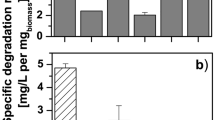Abstract
The degradation of α and β isomers of endosulfan by a two-member bacterial co-culture was studied. Results were similar whether the two isomers were present individually or together, as in technical endosulfan. The degradation of both isomers was accompanied by the formation of endosulfan diol and endosulfan lactone. Accumulation of the metabolite, endosulfan sulfate was, however, not observed during the reaction with either of the isomers. The microbial degradation of endosulfan isomers was also accompanied by a decrease in its toxicity to the test organism Tubifex tubifex Müller.





Similar content being viewed by others
References
ASTDR (2000) Toxicological profile for endosulfan. US Department of Health and Human Services, Agency for Toxic Substances and Disease Registry, Atlanta, Ga., USA
Awasthi N, Manickam N, Kumar A (1997) Biodegradation of endosulfan by a bacterial coculture. Bull Environ Contam Toxicol 59:928–934
Awasthi N, Ahuja R, Kumar A (2000) Factors influencing the degradation of soil-applied endosulfan isomers. Soil Biol Biochem 32:1697–1705
Bouche ML, Habets F, Biagianti-Risbourg S, Vernet G (2000) Toxic effects and bioaccumulation of cadmium in the aquatic oligochaete Tubifex tubifex. Ecotoxicol Environ Safety 46:246–251
Cairns J Jr, Niederlehner BR (1994) Ecological toxicity testing. CRC, Boca Raton, Fla., USA
Chaudhuri K, Selvaraj S, Pal AK (1999) Studies on the genotoxicity of endosulfan in bacterial systems. Mutat Res 439:63–67
Coleman PF, Dolinger PM (1982) : Environmental health evaluation of California restricted pesticides. (Endosulfan monograph no 4) PM Dolinger Associates, Menlo Park, Calif., USA
Cotham WE Jr, Bidleman TF (1989) Degradation of malathion, endosulfan and fenvelarate in sea water and sea water/sediment in microcosms. J Agric Food Chem 37:824–828
El Beit IOD, Wheelok JV, Cotton DE (1981) Factors affecting soil residues of dieldrin, endosulfan gamma HCH, dimethoate and pyrolan. Ecotoxicol Environ Safety 5:135–160
Goebel H, Gorbach S, Knauf W, Rimpau RH, Huttenbach H (1982) Properties, effects, residues and analysis of the insecticide endosulfan. Residue Rev 83:40–41
Guerin TF (1999) The anaerobic degradation of endosulfan by indigenous microorganisms from low oxygen soils and sediments. Environ Pollut 106:13–21
Katayama A, Matsumura F (1993) Degradation of organochlorine pesticides, particularly endosulfan, by Trichoderma hazianum. Environ Toxicol Chem 12:1059–1065
Kaur I, Mathur RP, Tandon SN (1998) Persistence of endosulfan (technical) in water and soil. Environ Technol 19:115–119
Kidd H, James DR (1991) The agrochemical handbook, 3rd edn. Royal Society of Chemistry Information Services, Cambridge, UK
Kovacs MF (1965) Thin layer chromatography for pesticide residue analysis. J Assoc Off Agric Chem 48:1018–1022
Kullman SW, Matsumura F (1996) Metabolic pathway utilized by Phanerochete chrysosporium for degradation of the cyclodiene pesticide endosulfan. Appl Environ Microbiol 62:593–600
Lenke H, Warrelmann J, Daun G, Hund K, Sieglen U, Walter U, Knackmuss H-J (1998) Biological treatment of TNT contaminated soil. 2. Biologically induced immobilization of the contaminants and full scale application. Environ Sci Technol. 32:1964–1971
Martens R (1976) Degradation of (8,9 C14) endosulfan by soil microorganisms. Appl Environ Microbiol 6:853–858
Rao DMR, Murty AS (1980) Persistence of endosulfan in soils. J Agric Food Chem 28:1099–1101
Samanta SK, Chakraborti AK, Jain RK (1999) Degradation of phenanthrene by different bacteria: evidence for novel transformation sequences involving the formation of 1-naphthol. Appl Microbiol Biotechnol 53:98–107
Smith AG (1991) Chlorinated hydrocarbon insecticides. In: Hays WJ Jr, Laws ER Jr (eds) Handbook of pesticide toxicology. Academic Press, New York, pp 731–915
Stewart DKR, Cairns KG (1974) Endosulfan persistence in soil and uptake by potato tubers. J Agric Food Chem 22:984–986
Sutherland DT, Horne I, Lacey MJ, Harcourt RL, Russel RJ, Oakeshott JG (2000) Enrichment of an endosulfan-degrading mixed bacterial culture. Appl Environ Microbiol 66:2822–2828
Acknowledgements
We thank the Department of Biotechnology, New Delhi, India, for financial assistance. All the experiments reported in the manuscript comply with the current laws of the country.
Author information
Authors and Affiliations
Corresponding author
Rights and permissions
About this article
Cite this article
Awasthi, N., Singh, A.K., Jain, R.K. et al. Degradation and detoxification of endosulfan isomers by a defined co-culture of two Bacillus strains. Appl Microbiol Biotechnol 62, 279–283 (2003). https://doi.org/10.1007/s00253-003-1241-7
Received:
Revised:
Accepted:
Published:
Issue Date:
DOI: https://doi.org/10.1007/s00253-003-1241-7




